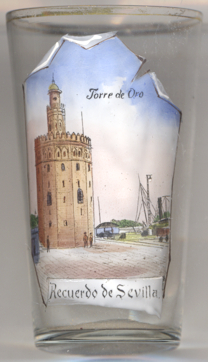

|
| ESPAÑA | Spain |
| Andalucía | Andalusia |
| provincia: Sevilla |
 Sevilla (in English: Seville) is the capital and largest city of the Spanish autonomous community of Andalusia and the
province of Seville. It is situated on the lower reaches of the River Guadalquivir, in the southwest of the Iberian Peninsula.
Seville has a municipal population of about 701,000 as of 2022, and a metropolitan population of about 1.5 million, making it the
fourth-largest city in Spain and the 25th most populous municipality in the European Union. Its old town, with an area of 4 square
kilometres, contains a UNESCO World Heritage Site comprising three buildings: the Alcázar palace complex,
the Cathedral and the General Archive of the Indies (listed in 1987).
Sevilla (in English: Seville) is the capital and largest city of the Spanish autonomous community of Andalusia and the
province of Seville. It is situated on the lower reaches of the River Guadalquivir, in the southwest of the Iberian Peninsula.
Seville has a municipal population of about 701,000 as of 2022, and a metropolitan population of about 1.5 million, making it the
fourth-largest city in Spain and the 25th most populous municipality in the European Union. Its old town, with an area of 4 square
kilometres, contains a UNESCO World Heritage Site comprising three buildings: the Alcázar palace complex,
the Cathedral and the General Archive of the Indies (listed in 1987).
Seville was founded as the Roman city of Hispalis. Known as Ishbiliyah after the Islamic conquest in 711, Seville became the
centre of the independent Taifa of Seville following the collapse of the Caliphate of Córdoba in the early 11th century; later
it was ruled by Almoravids and Almohads until being incorporated to the Crown of Castile in 1248. Owing to its role as gateway of the Spanish
Empire's trans-atlantic trade, managed from the Casa de Contratación, Seville became one of the largest cities in Western Europe in
the 16th century. Coinciding with the Baroque period, the 17th century in Seville represented the most brilliant flowering of the
city's culture. Following a deterioration in drought conditions in the Guadalquivir, the American trade gradually moved away from the city of
Seville, in favour initially of downstream-dependent berths and eventually of the Bay of Cádiz, to which were
eventually transferred control of both the fleets of the Indies (1680) and the Casa de Contratación (1717). The 20th century in
Seville saw the tribulations of the Spanish Civil War, decisive cultural milestones such as the Ibero-American Exposition of 1929 and
The  Torre del Oro ('Tower of Gold') is a dodecagonal military watchtower, erected by the Almohad Caliphate in
order to control access to Seville via the Guadalquivir river. Constructed in the first third of the 13th century, the tower served as
a prison during the Middle Ages. Its name comes from the golden shine it projected on the river, due to its building materials (a mixture of
mortar, lime and pressed hay). The tower is divided into three levels, the first level, dodecagonal, was built in 1220 by order of the Almohad
governor of Seville, Abù l-Ulù. As for the second level, of only 8 meters, also dodecagonal, was built by King Pedro I
of Castile in the 14th century, a hypothesis that has been confirmed by archaeological studies. The third and uppermost being
circular in shape was added after the previous third level, Almohad, was damaged by the 1755 Lisbon earthquake.
Rebuilding of the third level was made by military engineer Sebastian
Torre del Oro ('Tower of Gold') is a dodecagonal military watchtower, erected by the Almohad Caliphate in
order to control access to Seville via the Guadalquivir river. Constructed in the first third of the 13th century, the tower served as
a prison during the Middle Ages. Its name comes from the golden shine it projected on the river, due to its building materials (a mixture of
mortar, lime and pressed hay). The tower is divided into three levels, the first level, dodecagonal, was built in 1220 by order of the Almohad
governor of Seville, Abù l-Ulù. As for the second level, of only 8 meters, also dodecagonal, was built by King Pedro I
of Castile in the 14th century, a hypothesis that has been confirmed by archaeological studies. The third and uppermost being
circular in shape was added after the previous third level, Almohad, was damaged by the 1755 Lisbon earthquake.
Rebuilding of the third level was made by military engineer Sebastian
[https://en.wikipedia.org/wiki/Seville]
![[scale]](lineal.jpg)